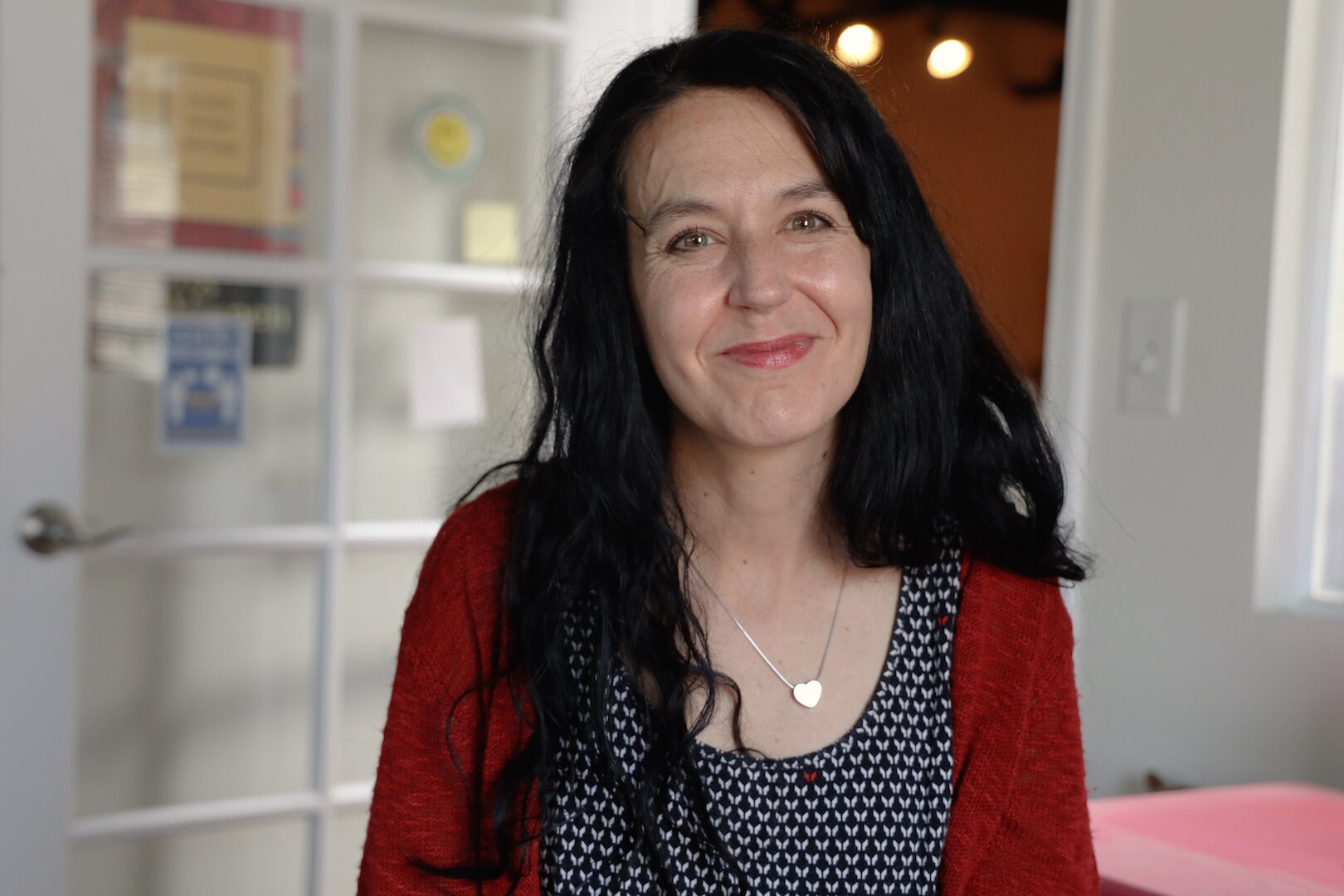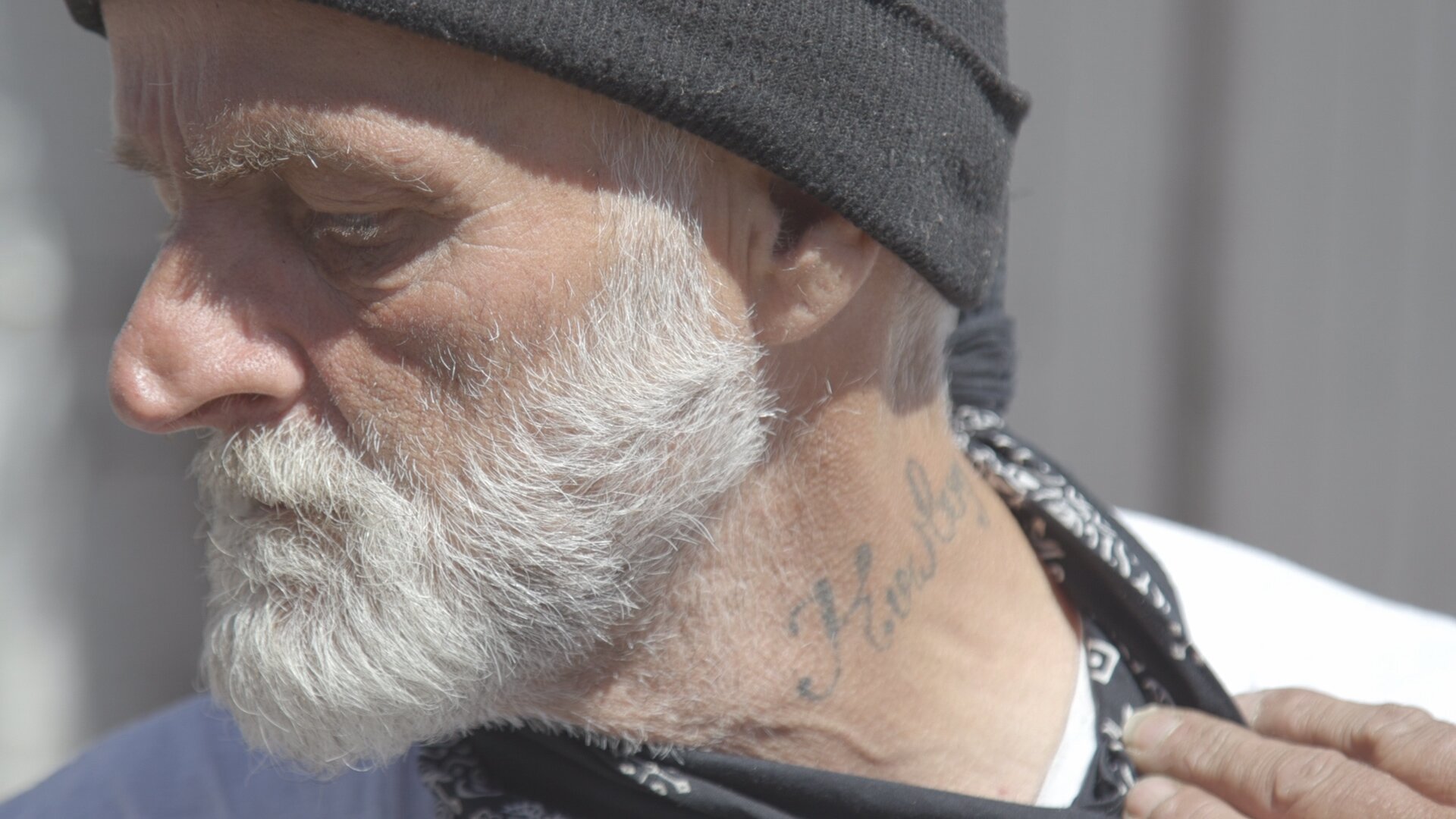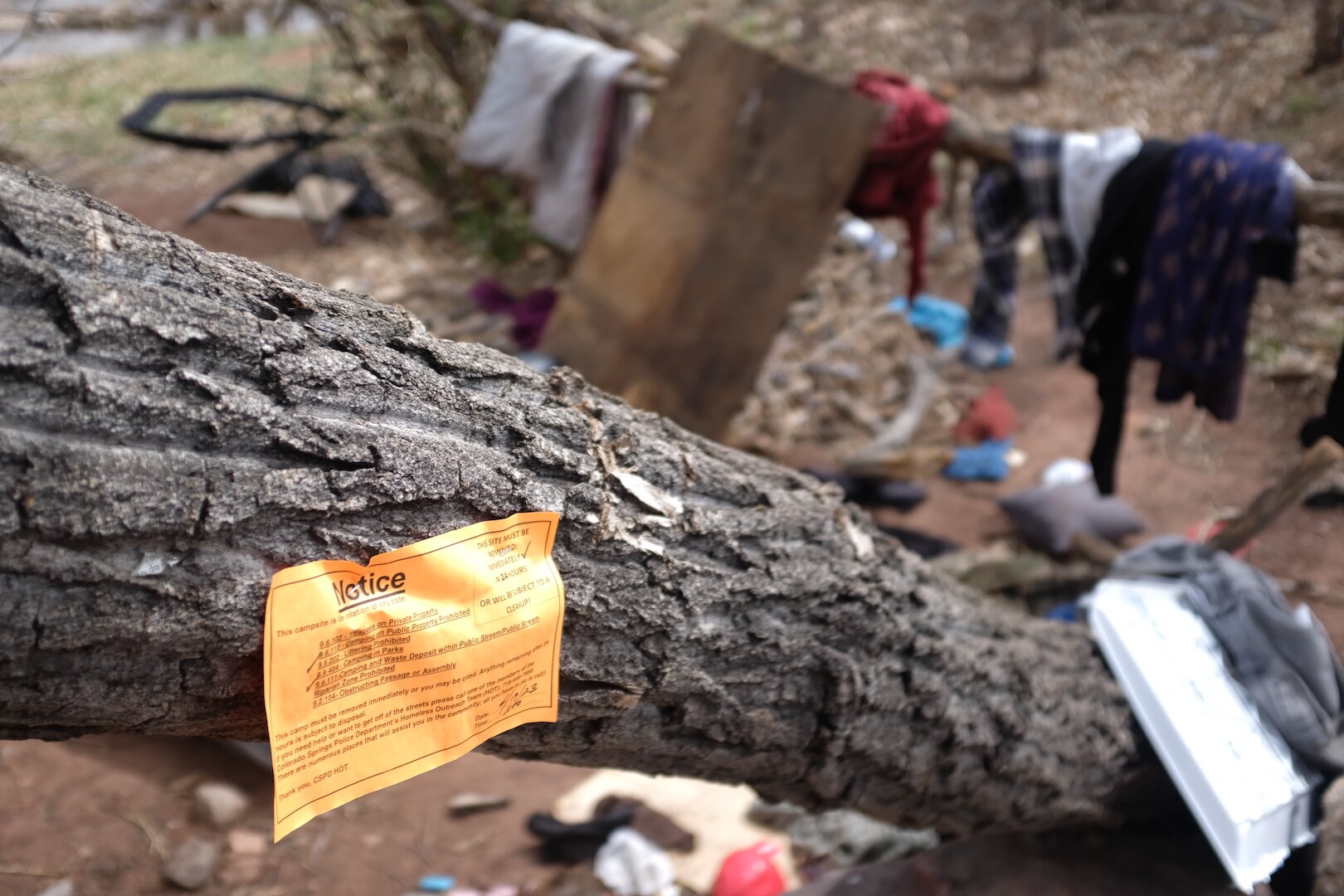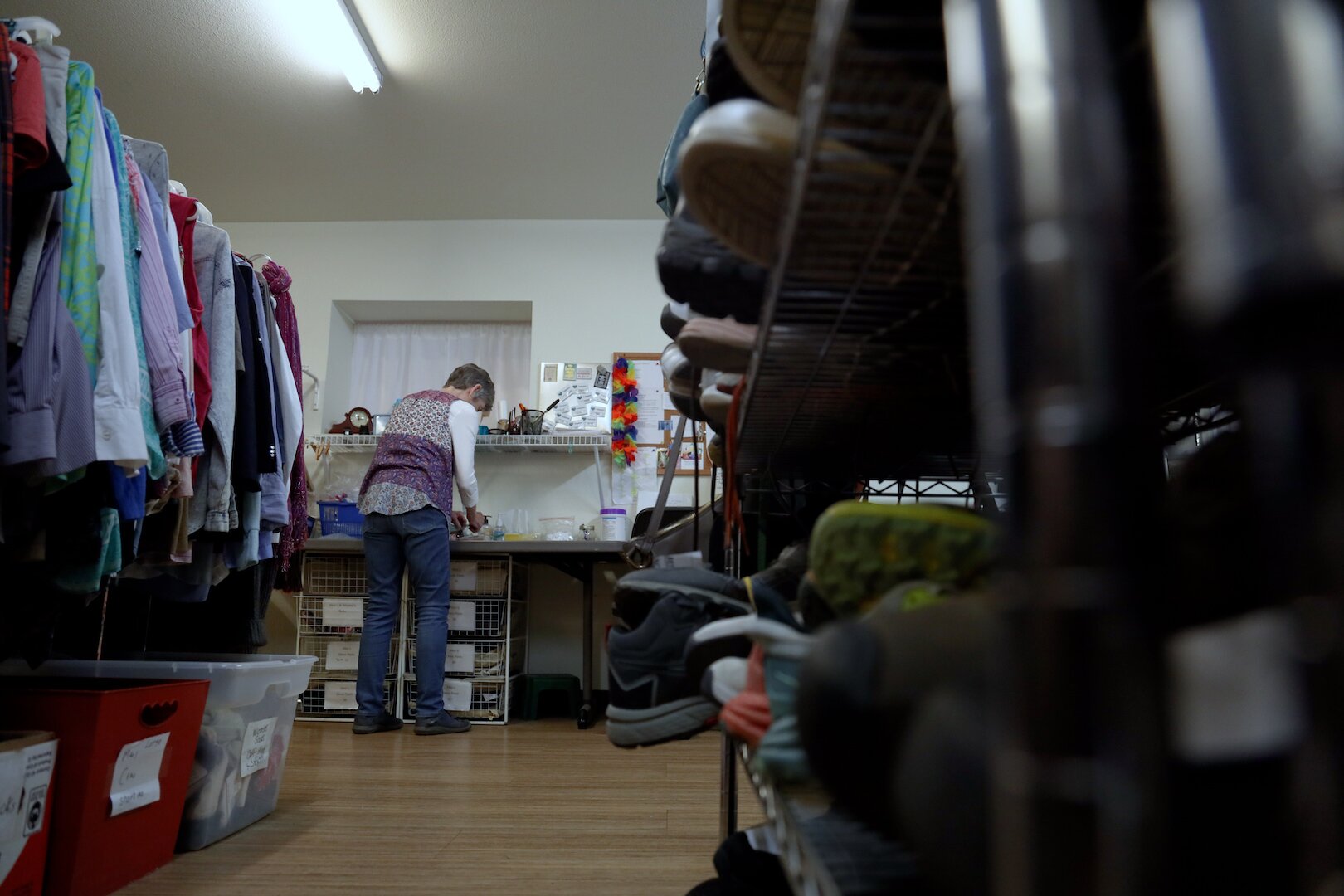On Colorado Springs’ west side, unhoused population build community to survive daily challenges

This story is one of several in a Rocky Mountain PBS series documenting homelessness in Colorado Springs. This series will be part of the upcoming season of Colorado Experience.
COLORADO SPRINGS, Colo. — Sleeping bags, suitcases and shopping carts line the parking lot of Westside Cares, an organization that provides mailing addresses for unhoused people, along with food, hygiene supplies, and rental assistance. It’s one of several direct services nonprofits serving unhoused people in Colorado’s second-largest city — and one of only two west of I-25.
While waiting for doors to open and names to be called, many of the unhoused neighbors passed the time smoking cigarettes. Some exchanged hugs and fist bumps while others stared at the gravel beneath their feet. Two people passed a cannabis pipe, the skunky odor of smoke permeating through the air. One woman took a swig out of a Jack Daniels bottle.
Arriving to the facility, Westside Cares CEO Kristy Milligan acknowledged the whiskey. “You’d better put that away, friend,” she said.
Related Stories
Milligan says she doesn’t judge the woman for drinking or the pair for smoking weed. She understands why people experiencing homelessness use substances: their lives are in a constant state of pressure as they try to survive harsh weather, outrun police and avoid conflict with other houseless neighbors.
But Milligan also knows that having open containers of alcohol and cannabis in public is a crime. And it’s one that houseless people are often targeted for.
Circling Westside Cares on a Monday morning, Milligan is greeted with hugs. Eyes light up, heads lift, and smiles emerge on previously solemn faces. She approaches others with sympathetic eyes and a warm smile. It’s, more than many receive while living on the streets.
“We know all of these people. Sometimes we know their full name; sometimes we know their street name,” Milligan said. “Our job is to help.”
The most important service the organization provides, Milligan believes, is getting people into housing.
“The vast majority of people are actively pursuing housing,” Milligan said. “The folks who aren’t looking or say that they don’t want housing just don’t believe they’re deserving.”
In 2022, Westside Cares helped 25 people find homes, with an 85% retention rate averaging throughout the years. About 750 people are on Westside Cares’ list for eventual housing, with hundreds more spread across the city. While Milligan knows many will wait unknown lengths of time, she does everything she can to help navigate what she sees as a convoluted process.
When a houseless neighbor reaches Milligan’s desk, she first asks about their support system.
“Overwhelmingly, their answer is they don’t have one,” Milligan said.
Milligan and her staff analyze an individual’s existing barriers to housing, she said, and talk through options. Sometimes, she said, a neighbor is entitled to veteran’s benefits or social security payments they’re not receiving. Sometimes they’re experiencing domestic violence and can be linked with resources from a safehouse. If someone is willing to stop using substances, they may be able to relocate to a sober living home that fits their needs.
But usually, Milligan said, the process calls for more complex steps.

Colorado requires those applying for government-supported housing to fill out an online survey called the Vulnerability Index – Service Prioritization Decision Assistance Tool (VISPDAT). The VISPDAT asks about a person’s health issues, years of homelessness, incarceration, financial issues and other factors contributing to their homelessness.
From there, a person is assigned a number assessing how “vulnerable” they are. Each week, housing leaders around the city gather and select names based on vulnerability and needs. In theory, Milligan said, the more vulnerable a person is, the faster they get into housing. But some housing options have barriers set so high for those with a history of eviction or incarceration that folks remain on a list for years.
“If someone says, as many people do, ‘I want to be sober, but I can’t get sober until I feel safe,’ then we move to the next option,” Milligan explained. “We have a man who got stone-cold sober sleeping on the concrete. But that isn’t possible for most people.”
While reality is bleak for most unhoused people, some do get lucky.
Donald “Kowboy” Parks threw his arms around Milligan when he heard the news: after eight years of homelessness and three months on standby, he was getting a place to call his own. On Tuesday, Kowboy moved into The Commons, Colorado Springs’ newest permanent supportive housing complex.
Policing without the police
Kowboy earned his nickname while serving in the United States Army. He was first stationed in Washington, then retired at Fort Carson, just south of Colorado Springs. He lost his home eight years ago after a relationship ended and the low salary from his part-time job failed to pay rising rent and expenses.
The nickname “Kowboy” is tattooed just below his collarbone. He got this tattoo as a reminder to be responsible.
“It just helps me be accountable with my name on my neck,” Kowboy said. “I hope to be accountable for my actions.”
Many of those experiencing homelessness have had negative interactions with the police, and see police as tools of oppression and enforcement, rather than a prospect for help, Kowboy said.
“We ain’t that much to them,” he said. “It’s not a game. This is our life. Quit messing with us.”
Many interviewed by Rocky Mountain PBS have described painful interactions with the Colorado Springs Police Department Homeless Outreach Team, claiming the team takes their belongings without regard to how a person can survive outside without a tent or sleeping bag. These interactions can present as cruel and brutal.
Many living outside choose to police themselves, following a certain enforcement code and complying with orders from specific individuals.
“I’d rather talk to them than have the police come and talk to them because the cops have a different way of doing things. To them, it's a game. To us, it’s our life.” Kowboy said. “So, we police our own out here.”

Kowboy was a medic in the U.S. Army. Today, he uses his training to help wounded soldiers assist other unsheltered people. He carries Naloxone in case of an opioid overdose, medication for other ailments, and bandages for cuts or scars. He also corrects people who leave trash outside or cause problems in other ways.
“I try to get to it before the cops do because I consider these people my family out here,” Kowboy added. “I either educate them or school them or use it like a learning experience.”
As for the unspoken “code,” of living on the West Side, Skittles, another long-time Westsider, said it’s simple: don’t leave trash out, don’t hurt women, children or older people, and don’t steal from others.
“The first time you hurt a woman, it’s a warning,” Skittles said. “The next time it happens, we’ll beat your a––.”
When conflict breaks out among unhoused neighbors, fights sometimes happen, Skittles said — but it’s still better than involving police.
“If you tell somebody not to do something and they still do it and you don't whoop their a––, ain’t no telling what they’ll do to the next person,” Skittles said. “But the cops are our worst enemy, so we never get them involved. They’re not here to help. They’re here to hurt.”
Skittles is from Texas. At the age of 12 he ran away from home and has been unhoused on-and-off ever since. A well-kept gray beard accents his face and a camouflage hat keeps his head warm on cold days. He walks around with a jar of peanut butter with half of the label ripped off, revealing a bag of marijuana inside the jar.
He doesn’t give out his birth name and said he’s known only by “Skittles.”
“Sweet like the candy,” he said.
Skittles spends most days at Vermijo Park with other Westsiders. He does his best to avoid trouble but said police often target unhoused residents for laws that don’t seem to apply to housed counterparts.
“Having fun out here is illegal for us,” he said. “Even if it’s legal, innocent fun. It ain’t legal for us.”
Skittles also knows that most housed people take issue with tents, tarps and trash lining the ground. Tents and sleeping bags are necessary for survival, he said, but leaving other trash on the ground is unacceptable, as it makes matters worse for all unhoused people, not just the ones who left the trash.
“If we catch you trashing stuff, we’ll trash you,” Skittles said.
The system isn’t perfect, Skittles and Kowboy said. But Westsiders know and, in large part, respect each other.
“We watch people lose their f–ing minds out here,” Skittles said. “And I get it. Having to do what we do every day — you got the police and the public after you. We have no one looking after us but ourselves.”

Living on the West Side
Snuggled beneath the Front Range foothills and silhouette of Pikes Peak, the west side of Colorado Springs stretches between Interstate Highway 25 and 31st Street, running along Colorado Highway 24. Old Colorado City — decorated with quaint shops, bar patios and red brick buildings — attracts tourists to the area.
Many unhoused people said they chose the West Side because of its proximity to mountain views and ample open space in parks and trails. Tourists heading to Manitou Springs or Woodland Park. who may be willing to toss a couple bucks to folks asking for money on sidewalks and medians. And being close to Westside Cares brings easy access to food and services.
“The West Side is the best place to be,” said Susan Shaiffer, an unhoused person waiting for services at Westside Cares. “It’s pretty. The people are a little more chill.”
Vermijo Park – a West Side grassy area with basketball hoops and picnic tables – intersects with the Midland Trail just east of Fountain Creek. Much of the West Side’s unhoused population call the park and creek home.
“It’s kind of like our own neighborhood out here,” said Jimbo, a homeless man at the park on a rainy Friday. “Not like those gated houses, but our own thing.”
The West Side has garnered attention for being a houseless hub. Some housed folks in the area have complained about trash, drug usage use and illegal fires. The Colorado Springs Indy recently published a story about the homelessness crisis referring to Highway 24 as a “homeless highway.”
Newly elected Colorado Springs Mayor Yemi Mobolade campaigned on reducing homelessness in the city. He named the issue under his “public safety” priorities in a blueprint outlining the plan for his first 100 days in office. In an interview with Rocky Mountain PBS, Mobolade said the issue has a negative impact on both the housed and the unhoused.
“There’s violence happening. That’s not new information, and it’s also unsafe for many of our residents,” Mobolade said. “It’s a public safety issue for both (housed) residents and for our homeless residents as well.”
Advocates and other unhoused Westsiders say the stigma of being seen as a societal burden is one of the largest problems faced. Of the dozens of interviews conducted by Rocky Mountain PBS of people experiencing homelessness, each person attested to picking up trash, using fires only when necessary and actively trying to minimize the impact they have on their environment.

“This is sort of a tired thing to say, but I think one of the biggest struggles of people experiencing homelessness is the dehumanization,” Milligan said. “Whatever trauma someone has experienced that caused them to become homeless is compounded by the marginalization and the stereotypes.”
Those who live outside said they’re tired of being blamed for others’ problems.
“I don’t litter. I get up every morning and take an entire area of nothing but trash that other people brought in,” Shaiffer said. “The West Side really does care. We try our best out here and it’s hard when you’re constantly being pushed down by these systems.”
Shaiffer was diagnosed with post-traumatic stress disorder after leaving an abusive relationship. She’s been on the streets for about 10 years after losing her job at Pikes Peak State College. Her PTSD diagnosis makes it difficult to hold down a job, she said.
“I felt stupid being in a military town and being diagnosed with PTSD,” she said. “I’m not a hero. I wasn’t in the military.”
Shaiffer has faced what often feel like impossible challenges on the street. She said she’s had vital medication stolen in interactions with police, along survival tools like tents. Without a tent, those living outside are left to freeze in the winter, often to the point of health hazards.
“You take my shelter, you take my medications, you take my food, you take my freedom,” Shaiffer said. “And then you take us to jail, and you throw us back out with nothing.”
Despite spending days struggling for survival, Shaiffer is optimistic and eager to talk about her life while offering to help others around her.
“It’s easy to become selfish and hard out here,” Shaiffer said. “But it’s one step at a time.”
Sometimes Shaiffer feels like she’s taking one step forward and four steps back. But eventually, she hopes, six steps forward will pull her out of homelessness and into a better life.
Hope is all she has, she emphasized.
Alison Berg is a journalist at Rocky Mountain PBS. You can reach her at alisonberg@rmpbs.org.
Zach Ben-Amots is an investigative multimedia journalist at Rocky Mountain PBS. You can reach him at zachben-amots@rmpbs.org.